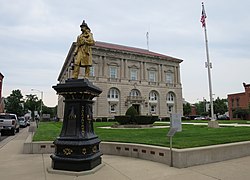2010 census
As of the 2010 United States census, there were 34,499 people, 12,872 households, and 9,556 families living in the county. [19] The population density was 71.5 inhabitants per square mile (27.6/km2). There were 13,731 housing units at an average density of 28.5 per square mile (11.0/km2). [20] The racial makeup of the county was 95.7% white, 0.3% black or African American, 0.2% Asian, 0.2% American Indian, 2.7% from other races, and 0.9% from two or more races. Those of Hispanic or Latino origin made up 5.5% of the population. [19] In terms of ancestry, 65.6% identified as German, 7.8% were Irish, 7.3% were American, 4.7% were English, 2.4% were French, 1.8% were Swiss, 1.7% were Dutch, 1.6% were Italian, 1.4% were Scottish, 1.0% were Welsh, 0.8% were Hungarian and 0.8% were Polish. [21]
Of the 12,872 households, 35.0% had children under the age of 18 living with them, 62.9% were married couples living together, 7.4% had a female householder with no husband present, 25.8% were non-families, and 22.5% of all households were made up of individuals. The average household size was 2.66 and the average family size was 3.13. The median age was 39.0 years. [19]
The median income for a household in the county was $56,573 and the median income for a family was $65,882. Males had a median income of $44,417 versus $33,200 for females. The per capita income for the county was $24,023. About 5.8% of families and 7.1% of the population were below the poverty line, including 9.8% of those under age 18 and 7.0% of those age 65 or over. [22]
2000 census
As of the census [23] of 2000, there were 34,726 people, 12,200 households, and 9,308 families living in the county. The population density was 72 people per square mile (28 people/km2). There were 12,753 housing units at an average density of 26 per square mile (10/km2). The racial makeup of the county was 96.26% White, 0.17% Black or African American, 0.15% Native American, 0.18% Asian, 0.01% Pacific Islander, 2.51% from other races, and 0.73% from two or more races. 4.38% of the population were Hispanic or Latino of any race.
There were 12,200 households, out of which 39.20% had children under the age of 18 living with them, 64.90% were married couples living together, 7.40% had a female householder with no husband present, and 23.70% were non-families. 21.30% of all households were made up of individuals, and 10.50% had someone living alone who was 65 years of age or older. The average household size was 2.81 and the average family size was 3.29.
In the county, the population was spread out, with 29.70% under the age of 18, 8.30% from 18 to 24, 28.10% from 25 to 44, 20.60% from 45 to 64, and 13.30% who were 65 years of age or older. The median age was 35 years. For every 100 females there were 98.50 males. For every 100 females age 18 and over, there were 97.00 males.
The median income for a household in the county was $46,426, and the median income for a family was $52,859. Males had a median income of $36,548 versus $23,963 for females. The per capita income for the county was $18,680. About 4.00% of families and 5.60% of the population were below the poverty line, including 6.40% of those under age 18 and 9.80% of those age 65 or over.






